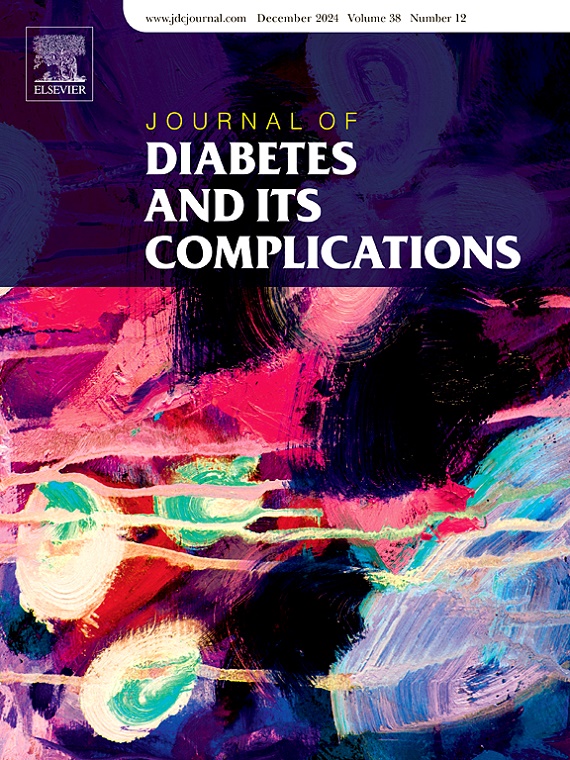High fat-induced the upregulation of LOX-1 in RF/6A cells under high glucose condition
IF 2.9
3区 医学
Q3 ENDOCRINOLOGY & METABOLISM
引用次数: 0
Abstract
Objective
To investigate the effect of ox-LDL on the expression of lectin-like receptor of ox-LDL (LOX-1) and intercellular adhesion molecule-1 (ICAM-1) in RF/6A cells under high-glucose condition.
Methods
RF/6A cells were cultured in normal or high-glucose medium for two days. Furthermore, RF/6A cells were cultured in medium with high glucose and ox-LDL or normal medium with ox-LDL. The concentrations of ox-LDL were determined by initial screening based on migration and immunofluorescence. The expressions of LOX-1 and ICAM-1 were determined by western blot.
Results
The maximal effect of glucose on RF/6A cells was observed with the concentration of 25 mmol/l for 48 h. The LOX-1 expression was upregulated under high glucose condition than normal glucose (p < 0.05). There were significant LOX-1 overexpression and blocked ICAM-1 activation in RF/6A cells under high-glucose condition (p < 0.05). In the normal medium with ox-LDL groups, LOX-1 expression was both increased than in the normal medium group (p < 0.05). In the high glucose medium with ox-LDL groups, the expression levels of LOX-1 and ICAM-1 were increased than the high glucose medium group (p < 0.05).
Conclusion
A certain concentration of ox-LDL blocks high-glucose-induced retinal vascular endothelial injury by inhibiting the upregulation of ICAM-1 due to a high-glucose environment. Dyslipidemia may play an important role in the development of diabetic retinopathy, emphasizing the importance of active regulation of blood lipids in diabetic retinopathy therapy.
高脂诱导高糖条件下RF/6A细胞LOX-1表达上调
目的探讨高糖条件下ox-LDL对RF/6A细胞ox-LDL凝集素样受体(LOX-1)和细胞间粘附分子-1 (ICAM-1)表达的影响。方法srf /6A细胞分别在正常或高糖培养基中培养2 d。此外,将RF/6A细胞培养于高糖和ox-LDL培养基或ox-LDL的正常培养基中。基于迁移和免疫荧光初步筛选ox-LDL的浓度。western blot检测LOX-1和ICAM-1的表达。结果葡萄糖在25 mmol/l浓度作用48 h时对RF/6A细胞的影响最大,高糖条件下LOX-1的表达比正常情况下上调(p <;0.05)。高糖条件下,RF/6A细胞中LOX-1过表达并阻断ICAM-1激活(p <;0.05)。在含有ox-LDL组的正常培养基中,LOX-1的表达均高于正常培养基组(p <;0.05)。ox-LDL组高糖培养基中,LOX-1和ICAM-1表达水平较高糖培养基组升高(p <;0.05)。结论一定浓度的ox-LDL通过抑制高糖环境下ICAM-1的上调来阻断高糖诱导的视网膜血管内皮损伤。血脂异常可能在糖尿病视网膜病变的发生发展中起重要作用,强调积极调节血脂在糖尿病视网膜病变治疗中的重要性。
本文章由计算机程序翻译,如有差异,请以英文原文为准。
求助全文
约1分钟内获得全文
求助全文
来源期刊

Journal of diabetes and its complications
医学-内分泌学与代谢
CiteScore
5.90
自引率
3.30%
发文量
153
审稿时长
16 days
期刊介绍:
Journal of Diabetes and Its Complications (JDC) is a journal for health care practitioners and researchers, that publishes original research about the pathogenesis, diagnosis and management of diabetes mellitus and its complications. JDC also publishes articles on physiological and molecular aspects of glucose homeostasis.
The primary purpose of JDC is to act as a source of information usable by diabetes practitioners and researchers to increase their knowledge about mechanisms of diabetes and complications development, and promote better management of people with diabetes who are at risk for those complications.
Manuscripts submitted to JDC can report any aspect of basic, translational or clinical research as well as epidemiology. Topics can range broadly from early prediabetes to late-stage complicated diabetes. Topics relevant to basic/translational reports include pancreatic islet dysfunction and insulin resistance, altered adipose tissue function in diabetes, altered neuronal control of glucose homeostasis and mechanisms of drug action. Topics relevant to diabetic complications include diabetic retinopathy, neuropathy and nephropathy; peripheral vascular disease and coronary heart disease; gastrointestinal disorders, renal failure and impotence; and hypertension and hyperlipidemia.
 求助内容:
求助内容: 应助结果提醒方式:
应助结果提醒方式:


